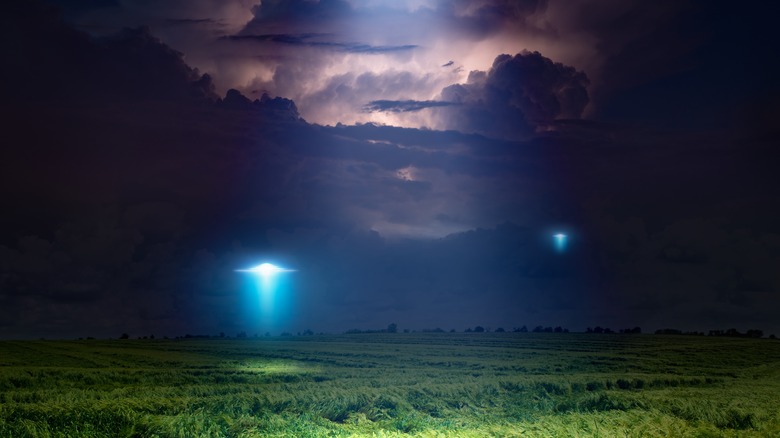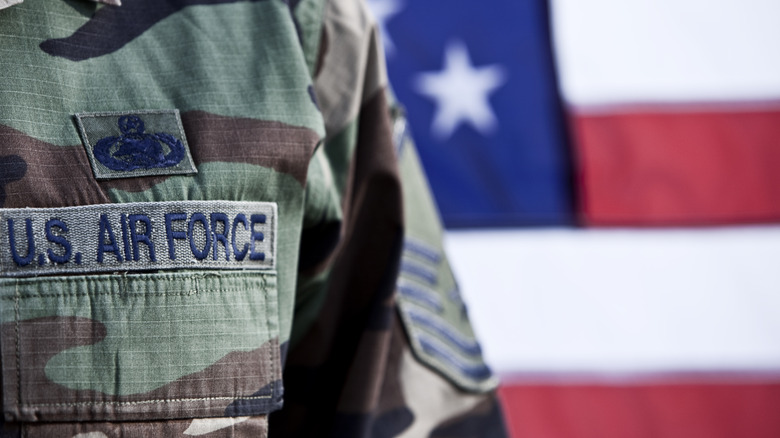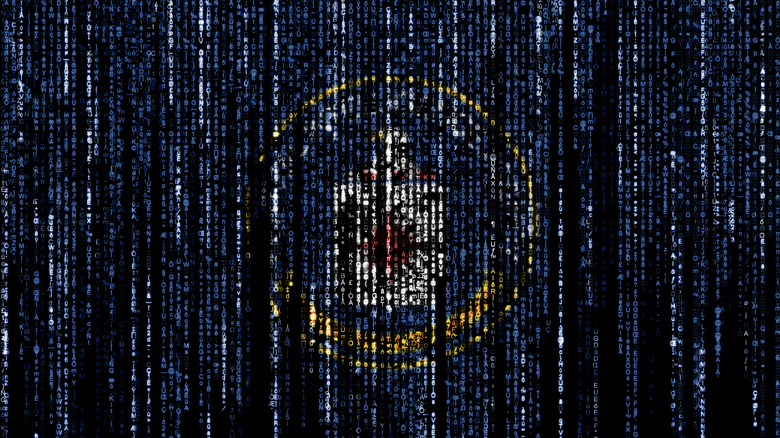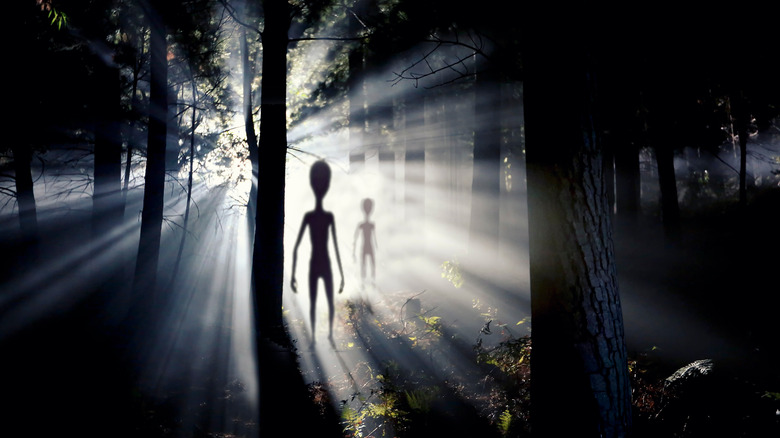Inside The Secret 1950s Air Force UFO-Investigation Program, Project Blue Book
Does anybody remember that slew of "Jesus' face is in my toast" sightings from some years back? Folks see lots of things that aren't there, same as they believe lots of things that aren't true. A weird thing on the horizon might be an optical fata morgana illusion, and a strange object in the sky might be a seagull swooping in to snatch your tuna sandwich. The human mind is wired to compose meaningful visual patterns from random inputs, a tendency called "pareidolia" that would have been very helpful for our ancestors to spot predators and prey. "Apophenia," meanwhile, is the cognitive tendency to erroneously connect information. So what about all the UFO sightings described by folks since forever? Well, the U.S. Air Force looked into it in the 1950s and concluded that it's all bupkis — at least in the official report.
So yes, the Air Force conducted an honest-to-goodness investigation into UFOs — or UAPs (Unidentified Aerial Phenomena), by the recent rebranding — all the way from 1947 to 1969 called "Project Blue Book," although it hit its zenith in the '50s. As the U.S. government's Executive Services Directorate reported in 1966, Project Blue Book fell under the purview of the U.S. Air Force as commissioned by the Department of Defense. Its main concern wasn't the existence of extraterrestrial life, but to determine if unidentified flying objects posed a security threat to the U.S. In the end, authorities determined that they didn't. Those authorities, however, were not too subtly guided by the CIA.
The Roswell connection
Full disclosure: Project Blue Book discovered zero aliens or anything literally otherworldly. It did, however, as the Executive Services Directorate reported in 1966, uncover hoaxes, hallucinations, missiles, reflections, flares, mirages, searchlights, clouds, birds, and other airborne objects. That being said, data from 1953 to 1965 did indeed include 253 unidentified flying objects, while 1965 included 17 "pending" objects awaiting classification. Please be aware that "unidentified flying object" means only what it says: an object that is flying that cannot be identified. It doesn't, sadly, mean alien spacecraft or those bug-eyed gray Zeta Retilucan dudes. Sorry, Mulder.
And yet, the timing of Project Blue Book's launch coincides with the singularly most well-known UFO incident in recent history: the 1947 Roswell crash. As that story goes, pilot Kenneth Arnold saw some weird "crescent-shaped objects" darting around in the sky at about 1,200 miles per hour near the Washington State's Cascade mountains "like a saucer would if you skipped it over water," per Sky at Night Magazine. About two weeks later nearby rancher "Mac" Brezel found some strange metallic debris on his property. At first, the U.S. military said the wreckage was one of Arnold's "flying saucers," but less than a day later took the statement back and said that the wreckage was a downed weather balloon.
Later that year Air Force Lt. General Nathan Twining described these publicly denied "flying disc[s]" as "something real and not visionary or fictitious," per The New York Times. He suggested the government take it seriously, and Project Blue Book was born.
Credible reports of incredible things
Project Blue Book was called Project Sign and Project Grudge before arriving at its final moniker, as the Executive Services Directorate's 1966 report says. The goals of the project were completely pragmatic and militarily-minded: 1) "to determine whether UFOs pose a threat to the security of the United States," and 2) "to determine whether UFOs exhibit any unique scientific information or advanced technology which could contribute to scientific or technical research." In other words: Can these things hurt us? And: Can we use their tech to blow stuff up? We're being facetious, but only a bit.
Early on, as The New York Times reports, personnel concluded — or maybe jumped to the conclusion — that if UFOs didn't belong to Russia they "most likely had an interplanetary origin." Chief of Staff of the Air Force General Hoyt Vandenberg dismissed such talk as nonsense and redirected Project Blue Book towards its eventual, prosaic end of hoaxes, flares, and birds.
Come 1952, Air Force Director of Intelligence Major-General John Stamford said that it was "not entirely impossible that the objects sighted may possibly be ships from another planet such as Mars," via The New York Times. In a briefing at the Pentagon on YouTube he mentions a small percentage of reports made by "credible observers of relatively incredible things." These sightings, however, did not "contain any pattern or purpose or of consistency that we can relate to with any threat conceivable to the United States," nor were they related to any secret government project.
The CIA debunking campaign
As The New York Times describes, the 1950s was a time of rampant UFO reports. It's also when the CIA twisted its tendrils into Project Blue Book and potentially mucked up the results of the report. This, consequently, opens the door for UFO believers to find fault in Project Blue Book, and even claim that the whole project was a complex disinformation campaign. At the very least, CIA involvement definitely steered the report's results.
In 1953 the CIA drafted a plan regarding "what should be told the public regarding the [UFO] phenomenon, in order to minimize risk of panic," via The New York Times. They also advocated training the public via "mass media such as television, motion pictures, and popular articles" about how to critique UFO claims, and suggested monitoring citizen groups interested in UFOs because they could have a "great influence on mass thinking if widespread sightings should occur." An article in the CIA journal Studies in Intelligence describes the agency's involvement during this time in detail and says that they backed off in the '60s.
As History explains, some have criticized the CIA for pushing Project Blue Book toward debunking UFOs rather than analyzing them. Astronomer J. Allen Hynek describes more than one occasion when Project Blue Book fudged data or dismissed UFOs as natural occurrences. "The entire Blue Book operation was a foul-up," he wrote. "Not enough attention was paid to the subject to acquire the kind of data needed even to decide the nature of the UFO phenomenon."
The truth is out there
So did Project Blue Book transform into a mere disinformation appendage of the CIA? If not for the influence of the U.S. intelligence community, there'd be far less reason to doubt the report's findings. Per the Executive Services Directorate's 1966 report, Project Blue Book concluded that UFOs are not a threat, not technologically useful, and not extraterrestrial in origin. But, remember how we discussed that authorities backpedaled on the Roswell crash and said that they'd discovered a weather balloon? Well, the FBI's report from that time states that internal conversations "had not borne out this belief," per the FBI Records vault. Are we to take Project Blue Book's very simple, commonplace conclusions as fact, then?
To this day members of the U.S. public — or anyone with an internet connection, really — can access official government information about Project Blue Book. The Air Force website contains a little synopsis of Project Blue Book and states that the project found nothing relevant. The site also dusts its hands off by saying that it's unlikely the Air Force would get involved in such a "costly project in the foreseeable future" because of "the current environment of steadily decreasing defense budgets." Meanwhile, Project Blue Book records have shifted over to the National Archives, which corroborates the study's anticlimactic results. And yet, UFO believers will find fault in these findings as surely as non-believers will take them as gospel. This doesn't, however, mean that aliens are the same as Jesus' face in your toast.




